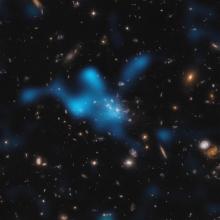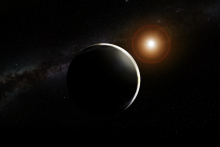Listen to today's episode of StarDate on the web the same day it airs in high-quality streaming audio without any extra ads or announcements. Choose a $8 one-month pass, or listen every day for a year for just $30.
You are here
Moon and Saturn
When big storms on Earth are done, they leave little trace in the atmosphere that they ever existed. On Saturn, though, big storms appear to leave traces even centuries after they faded from sight.
Saturn is the second-largest planet in the solar system — a ball of gas more than nine times the diameter of Earth. Its atmosphere is generally pretty bland — a few ribbons of clouds in shades of white, yellow, and tan. Every couple of decades, though, a giant storm breaks out. It can wrap all the way around the planet, and remain visible for months or years.
But a recent study found that the storms leave a long-lasting imprint.
Scientists used an array of radio telescopes in New Mexico to look for ammonia in Saturnian skies. They found regions where there was little ammonia high in the sky, but a lot at lower altitudes. All of those regions seemed to match the locations of the giant storms recorded since 1876 — with the possible imprint of one from centuries earlier.
The big storms might have caused ammonia high in the atmosphere to cool and condense, forming big “mushballs” of ice. The mushballs fell dozens of miles into the atmosphere. They vaporized, adding their ammonia to the lower altitudes — leaving traces of long-gone storms.
Saturn looks like a bright star, and is especially easy to find right now. It’s above the Moon as darkness falls tonight, and to the lower right of the Moon tomorrow night.
Script by Damond Benningfield





